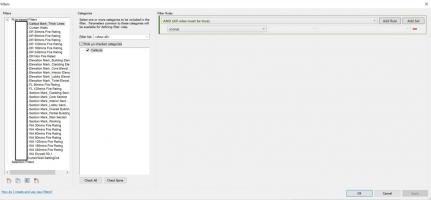User Settings

Chapter 16 - User Settings
User settings are either values that are subject to change, such as the holding period required for long term gain classification, or values that customize Capital Gainz for a particular user, such as reinvesting distributions.
[[Screen not in online version of documentation.]]
To change the user settings, you fill in the User Settings Form. This form is called up by selecting User Settings from the Main Menu. When a field requires a YES or NO value, then you'll see the current value followed by the valid choices. Thus, if a field is set to YES, you'll see:
Field:YES YES NOTo choose YES or NO, highlight your choice and hit Enter, or just hit the Y or N key. The settings specific to the Graphics Program, are described in Chapter 19, and can only be set from the Graphics Program.
Function keys at the bottom of the screen are:
- Form Accept - accept all entries, the same as hitting Enter on each field.
- Form Reject - exit immediately, the same as hitting Esc to back out of the form.
- F2:Set Screen Colors - change the color settings for the screen groups.
- F3:User Settings Report - print the User Settings Report.
- F9:Set Report Parameters - set parameters related to printing reports.
16.1 Settings
16.1.1 Long Term Holding Period in Days
The holding period entry is the number of days shares must be owned before they are classified as long term holdings. Depending on the current tax codes, long term gains may be taxed less than short term gains. Open shares are classified as long term if the current date exceeds the purchase date by more than the holding period; otherwise open shares are classified as short term. Gains or losses from selling shares are classified as long term if the date of the sale exceeded the purchase date by more than the holding period at the time of the sale; otherwise gains or losses from selling shares are classified as short term.
===>>> When you sell shares, long/short term status is determined by the current value of the holding period, and recorded in the record. Changing the holding period has no effect on closed shares records. This approach must be used to account for changes in the holding period from year to year. To change long/short term status for closed shares, change the records or execute the Apply Holding Period function from the Closed Shares Log.
The default is 365.
16.1.2 Confirm Adds/Confirm Updates/Confirm Deletes
You can request that Capital Gainz ask for confirmation before adding, changing, or deleting records. When a requested operation affects many records, such as a stock split or a sale, confirmation will always be requested, regardless of the confirmation settings.
[[Screen not in online version of documentation.]]
If confirmation is requested, then before the operation is executed the Confirm Form pops up. If you select YES, then the operation is performed. If you select NO or hit the Esc key, then the operation is not performed. This confirmation is a welcome safeguard for some, and an annoying nuisance to others. This is precisely why Capital Gainz leaves the settings up to you. Even if you don't care much for confirmations, it still may be wise to leave them on for deletions.
The defaults are NO for Add and Change, and YES for Delete.
16.1.3 Reinvest Distributions
You can have Capital Gainz bring up the Buy Shares Form to enter reinvestment information after recording a distribution. This is useful for mutual funds that automatically reinvest distributions.
The default is YES.
16.1.4 Redistribute Proceeds
You can have Capital Gainz bring up the Buy Shares Form to redistribute proceeds after recording a sale. This is useful for transferring funds into and out of a money market fund.
The default is NO.
16.1.5 Include Commission in Basis for Gain/Loss%
By default, the gain/loss calculations in Capital Gainz do not include commissions in the basis. Thus, you can actually have greater than a 100% loss. The motivation for this decision is that the commission amount is never actually used to purchase shares. Set this value to YES to include commissions in the basis, resulting in slightly lower absolute gain and loss percentages. The gain/loss amounts are the same whether or not commissions are included in the basis. See Chapter 20 for details on calculations used by Capital Gainz.
The default is NO.
16.1.6 Use Short Sales
If you never use short sales, leave this value set to NO. Even if you expect to use short sales, leave it set to NO until your first short sale. When you execute your first short sale, this value will automatically be set to YES.
You get slightly better performance when recording purchases if you don't need short selling. The slower performance is caused by searching the Closed Shares File for short sales to cover whenever you record a purchase.
The default is NO.
16.1.7 Backup Command
You enter the DOS command to be used to backup data files. Since most users already have backup or compression utilities, Capital Gainz allows you to use tools that you are already familiar with. However, only a single DOS command line can be entered, so to backup using DOS' COPY command you would have to write a batch file, and specify that file as the backup command.
Some examples of backup command entries would be:
o If PKZIP is available:
PKZIP -U A:CGDATA.ZIP *.DAT *.K01o If the 4DOS shell is installed:
COPY *.DAT *.K01 A:o If a batch file named BACKUP.BAT is used
BACKUPWhere the contents of BACKUP.BAT could be:
COPY *.DAT A:
COPY *.K01 A:===>>> As these commands show, the data files that must be backed up are identified by the DOS wildcards *.DAT and *.K01. If you have access to a data compression utility, use it to conserve backup disk space and to speed up the floppy disk transfer.
This field is initialized to CAPGNZBU A. CAPGNZBU.BAT is a DOS batch file included with Capital Gainz. It simply copies the data files to a specified disk drive. Another batch file, CAPGNZRS.BAT, restores the backed up files.
The default is CAPGNZBU A.
16.1.8 File Viewer
You enter the DOS command to be used to view reports sent to the screen. If you leave this field blank, then the default internal file viewer will be used. The internal viewer should be more than adequate for most users, as it supports searching and jumping to specific pages. However, you may want to use an external viewer that you've become accustomed to.
Since Capital Gainz must save an image of its internal process and shell out to DOS, an external file viewer takes much longer to bring up. In fact, this penalty is so great that it only makes sense to use an external file viewer if you defined a RAM disk as your temporary directory at installation. For details on using RAM disks, see Chapter 23.
An example of an external file viewer is the ever-popular LIST program. If you want to use LIST as your file viewer, and it's on your DOS PATH, just enter the following in the File Viewer Field:
LISTThe default is blank.
16.1.9 Price File Read at Startup
You can automatically have Capital Gainz read a file to update security prices at startup. If you update your security prices in the PRICES file before starting Capital Gainz, then enter the following in this field:
PRICES
It's not a problem if the same file is read in twice, as the entries just overwrite existing entries. See Chapter 9 for more information on using an ASCII file to update your security prices.
The default is blank.
16.1.10 Form Accept and Form Reject Keys
You may want to change the Capital Gainz Form Accept key from the default Ctrl-Enter value, or the Form Reject key from the default Ctrl-Esc. A range of other values is available. Just erase the displayed value and hit Enter to pop up the Keys Table, described below.
Ctrl-Esc conflicts with DOS 5.0, which uses it to suspend programs and swap them out to memory, and with Windows, which uses it to bring up the Task List. The DOS or Windows keys can be remapped, but it's easier to remap the Capital Gainz key.
The defaults are Ctrl-Enter and Ctrl-Esc.
16.1.10.1 Keys Table
[[Screen not in online version of documentation.]]
The Keys Table displays a range of values that can be used for the Form Accept or Form Reject keys. Highlight your choice and hit Enter.
The Utility Program and Graphics Program also use this setting.
16.2 Set Report Parameters
[[Screen not in online version of documentation.]]
The Set Report Parameters key brings up the Report Settings Form to set various printer related values. This form is also available from a key on the Report Menu, and can be called up prior to printing a report from a table. When called from the User Settings Form, any values set in the Report Settings Form are not written to disk until the User Settings Form is accepted. When called prior to printing a report, the entered values are written to disk when the Report Settings Form is completed.
Function keys at the bottom of the screen are:
- Form Accept - accept all entries, the same as hitting Enter on each field.
- Form Reject - exit immediately, the same as hitting Esc to back out of the form.
16.2.1 Append Reports
You can choose to either append or overwrite files when you send reports to a DOS file. If you choose not to append reports, existing files will be overwritten without warning.
The default is YES.
16.2.2 Lines Per Page
You can specify the number of report lines printed on each page. The default setting of 58 should work with most printers. For most dot matrix printers, this value can be set to 66 lines per page, resulting in some paper savings.
This value must be between 50 and 66, or be equal to 0. Setting lines per page to 0 will cause Capital Gainz to not insert page break characters, and to only print the page header on the first page. This is a good way to save paper.
The default is 58.
16.2.3 Line Draw Chars
===>>> By default, Capital Gainz uses the extended ASCII line drawing characters for borders and separators in printed reports. (These characters are the same as those used in the displayed forms.) Most printers can print these characters, but sometimes you have to flip a dip switch in your dot matrix printer or load the appropriate font for your laser printer. Otherwise, you'll see garbage or nothing where separator lines should be. If you don't want to change your printer's settings, select NO for the Line Draw Chars field. This substitutes the - and = characters for the similar line drawing characters.
The default is YES.
16.2.4 Strip Trailing CRs
The underlying software used by Capital Gainz adds a CR (carriage return) after every LF (line feed). This will cause some printers to misalign printing, occasionally resulting in a blank page. By setting this value to YES, Capital Gainz will strip these stray CRs from the output before sending it to the printer. Of course, this will slow down printing.
The default is YES.
16.2.5 Brief Formats
Several reports offer brief and long formats, as described in Chapter 15.
The default is NO.
16.2.6 Show Subtotals
Several reports print subtotals, as described in Chapter 15.
The default is NO.
16.3 Set Screen Colors
[[Screen not in online version of documentation.]]
You get to the Select Screen Colors screen from a function key on the User Settings Form. This screen lets you customize the screen colors. Screens are grouped by type:
- Portfolio Screens, such as the Portfolio Table and the Portfolio Form.
- Global Security Screens, such as the Global Security Table and the Global Security Form.
- Broker/Investment Company Screens, such as the Broker/Investment Company Table and the Broker/Investment Company Form.
- Local Security Screens, such as the Local Security Table and the Local Security Form.
- General Activity Screens, such as the Activity Menu.
- Buy Activity Screens, such as the Buy Shares Form and the Open Shares Log.
- Sell Activity Screens, such as the Sell Shares Form and the Closed Shares Log.
- Distr Activity Screens, such as the Record Distribution Form and the Distribution Log.
- Other Screens, such as the User Settings Form.
These screen types are further divided into screen kinds:
- Forms, such as the Local Security Form.
- Tables, such as the Open Shares Log.
- Other, such as the Activity Menu.
The screen types and kinds are displayed as a matrix on the Select Screen Colors screen. This screen and the Pick Foreground and Background Colors screen are always white on black, except where actual color settings are shown. The matrix on the Select Screen Colors screen shows Form, Table, and Other in the currently selected background/foreground colors for each screen type. To change the colors for a screen type/kind, position the pointer and hit Enter. This will bring up the Pick Foreground and Background Colors screen.
When you exit from the Select Screen Colors screen, you are asked to confirm the selected colors.
Function keys at the bottom of the screen are:
- Form Accept - accept all entries, the same as hitting Enter on each field.
- Form Reject - exit immediately, the same as hitting Esc to back out of the form.
The Utility Program and Graphics Program use the Other screen colors.
16.4 Pick Foreground and Background Colors
[[Screen not in online version of documentation.]]
The Pick Foreground and Background Colors screen is brought up by hitting Enter for a screen type/kind on the Select Screen Colors screen. At the top of the screen is an example of the currently selected colors. Two rows of color blocks show the colors available. To select the foreground or background color, position the pointer under the desired color in the row and hit Enter. The example at the top of the screen is updated to show what the color combination looks like. To accept the colors, enter YES to Accept Colors. Otherwise, enter NO.
Function keys at the bottom of the screen are:
- Form Accept - accept all entries, the same as hitting Enter on each field.
- Form Reject - exit immediately, the same as hitting Esc to back out of the form.
16.5 User Settings Report
The User Settings report is described in Chapter 15.
16.6 Example - Change User Settings
Say you want to change Line Draw Chars to NO, and the Form Accept/Form Reject Keys to F11/F12.
- Bring up the User Settings Form.
- Use Set Report Parameters to bring up the report settings, change Line Draw Chars to NO, and hit Form Accept.
- Back at the User Settings Form, change the Form Accept/Form Reject Keys to F11/F12, and hit Form Accept to write the new settings record.


























